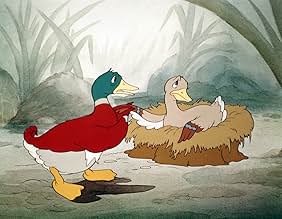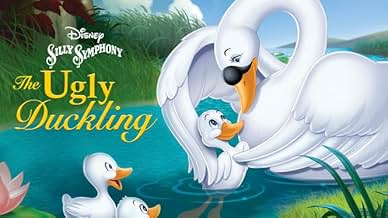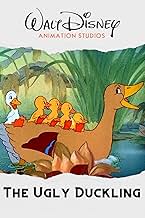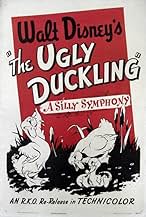CALIFICACIÓN DE IMDb
7.6/10
3.9 k
TU CALIFICACIÓN
Agrega una trama en tu idiomaA baby duckling is shunned by his family because he is different. He is also rejected by all of the other birds and animals. Finally a mother swan adopts him as one of her brood.A baby duckling is shunned by his family because he is different. He is also rejected by all of the other birds and animals. Finally a mother swan adopts him as one of her brood.A baby duckling is shunned by his family because he is different. He is also rejected by all of the other birds and animals. Finally a mother swan adopts him as one of her brood.
- Dirección
- Guionistas
- Elenco
- Ganó 1 premio Óscar
- 1 premio ganado en total
Amanda Cewel
- Mother Duck (speaking)
- (sin créditos)
Tom Cotry
- Father Duck (speaking)
- (sin créditos)
- Dirección
- Guionistas
- Todo el elenco y el equipo
- Producción, taquilla y más en IMDbPro
Opiniones destacadas
A Walt Disney SILLY SYMPHONY Cartoon Short.
A gawky UGLY DUCKLING, only moments after birth, is hectored & harried from the family of ducks he was born into. Will he ever find happiness & learn his true destiny?
This is a pleasant cartoon, with the plucky personality of the protagonist firmly front & center; the by-play between the duck parents is also amusing. Based on the Hans Christian Andersen classic, it is a remake of a 1931 black & white Symphony. The SILLY SYMPHONIES ended with this film, but they went out with a bang - like 6 of its predecessors, THE UGLY DUCKLING was awarded an Oscar for Best Animation.
The SILLY SYMPHONIES, which Walt Disney produced for a ten year period beginning in 1929, are among the most fascinating of all animated series. Unlike the Mickey Mouse cartoons in which action was paramount, with the Symphonies the action was made to fit the music. There was little plot in the early Symphonies, which featured lively inanimate objects and anthropomorphic plants & animals, all moving frantically to the soundtrack. Gradually, however, the Symphonies became the school where Walt's animators learned to work with color and began to experiment with plot, characterization & photographic special effects. The pages of Fable & Fairy Tale, Myth & Mother Goose were all mined to provide story lines and even Hollywood's musicals & celebrities were effectively spoofed. It was from this rich soil that Disney's feature-length animation was to spring. In 1939, with SNOW WHITE successfully behind him and PINOCCHIO & FANTASIA on the near horizon, Walt phased out the SILLY SYMPHONIES; they had run their course & served their purpose.
A gawky UGLY DUCKLING, only moments after birth, is hectored & harried from the family of ducks he was born into. Will he ever find happiness & learn his true destiny?
This is a pleasant cartoon, with the plucky personality of the protagonist firmly front & center; the by-play between the duck parents is also amusing. Based on the Hans Christian Andersen classic, it is a remake of a 1931 black & white Symphony. The SILLY SYMPHONIES ended with this film, but they went out with a bang - like 6 of its predecessors, THE UGLY DUCKLING was awarded an Oscar for Best Animation.
The SILLY SYMPHONIES, which Walt Disney produced for a ten year period beginning in 1929, are among the most fascinating of all animated series. Unlike the Mickey Mouse cartoons in which action was paramount, with the Symphonies the action was made to fit the music. There was little plot in the early Symphonies, which featured lively inanimate objects and anthropomorphic plants & animals, all moving frantically to the soundtrack. Gradually, however, the Symphonies became the school where Walt's animators learned to work with color and began to experiment with plot, characterization & photographic special effects. The pages of Fable & Fairy Tale, Myth & Mother Goose were all mined to provide story lines and even Hollywood's musicals & celebrities were effectively spoofed. It was from this rich soil that Disney's feature-length animation was to spring. In 1939, with SNOW WHITE successfully behind him and PINOCCHIO & FANTASIA on the near horizon, Walt phased out the SILLY SYMPHONIES; they had run their course & served their purpose.
For ten years, Walt Disney's talented animators pumped out cartoon after cartoon for his 'Silly Symphonies.' Walt decided it was time to shut down one of animation's most successful series. The final film of the 'Silly Symphonies' was April 1939's "The Ugly Duckling." The series went out with a bang, with the duck short winning the Academy Award for Best Short Subject (Cartoon), the 'Silly Symphonies' eighth Oscar win. The 75-cartoon series proved to be an invaluable testing ground for Disney to create and test new techniques and technologies, resulting in Walt's first feature film, 1938's "Snow White and the Seven Dwarfs."
Disney's animators, led by Jack Cutting and Ham Luske, had completed Hans Christian Andersen's fairy tale cartoon the year before. But Walt elected to hold off its release until he secured a Radio City Music Hall premier during the Easter Week which happened to front-end Fred Astaire and Ginger Rogers' "The Story of Vernon and Irene Castle." The 1939 version of "The Ugly Duckling" was his second telling of the 1843 Andersen story about a newly hatched white duckling who clearly didn't belong to the brood of baby mallard ducks the mother had just delivered. The most recent version was much sadder than its 1931 black-and-white predecessor, which played up the humorous aspects of the tale. But the Oscar-winning 1939 cartoon's ending was more in line with the written Andersen work than the earlier one.
"The Ugly Duckling" of 1939 concluded the 'Silly Symphonies'' storied series beginning in 1929 with "The Skeleton Dance." The string of successive cartoons was intended to be a platform for mainly musically-based animations with very little yapping. Over the course of its ten-year lifespan, the symphonies introduced a variety of innovations in animation, including the first three-strip Technicolor cartoon in 1932's "Flowers and Trees," special effects, more realistic human and animal movements, the multi-plane camera, and on and on. Only the cartoon series 'Tom and Jerry' would achieve the number of Academy Award wins as the 'Silly Symphonies.' After the overwhelming success of "Snow White," Walt decided to concentrate on his ambitious full-length films and his Mickey Mouse shorts. Some say the spirit of the series was carried on by his all-musical animated feature film, 1941's "Fantasia."
Disney's animators, led by Jack Cutting and Ham Luske, had completed Hans Christian Andersen's fairy tale cartoon the year before. But Walt elected to hold off its release until he secured a Radio City Music Hall premier during the Easter Week which happened to front-end Fred Astaire and Ginger Rogers' "The Story of Vernon and Irene Castle." The 1939 version of "The Ugly Duckling" was his second telling of the 1843 Andersen story about a newly hatched white duckling who clearly didn't belong to the brood of baby mallard ducks the mother had just delivered. The most recent version was much sadder than its 1931 black-and-white predecessor, which played up the humorous aspects of the tale. But the Oscar-winning 1939 cartoon's ending was more in line with the written Andersen work than the earlier one.
"The Ugly Duckling" of 1939 concluded the 'Silly Symphonies'' storied series beginning in 1929 with "The Skeleton Dance." The string of successive cartoons was intended to be a platform for mainly musically-based animations with very little yapping. Over the course of its ten-year lifespan, the symphonies introduced a variety of innovations in animation, including the first three-strip Technicolor cartoon in 1932's "Flowers and Trees," special effects, more realistic human and animal movements, the multi-plane camera, and on and on. Only the cartoon series 'Tom and Jerry' would achieve the number of Academy Award wins as the 'Silly Symphonies.' After the overwhelming success of "Snow White," Walt decided to concentrate on his ambitious full-length films and his Mickey Mouse shorts. Some say the spirit of the series was carried on by his all-musical animated feature film, 1941's "Fantasia."
The only reason I give this film a 9 and not a 10 is that it's actually a remake of a film this same studio made eight years earlier. I tend to be a little tougher on remakes plus it just doesn't take nearly as much effort to remake a film instead of do one from scratch. However, despite this concern, I can see why this film received the Oscar for Best Animated Short. It is simply wonderful from start to finish.
First, the animation is exactly what you'd expect from Disney from this era. In the 1930s, no other studio came close in quality of animation and music. The whole package was simply terrific and could not be beat. I particularly loved the wonderful backgrounds as well as the great use of colors--nicely muted and soft.
Second, the story, while very familiar to most, is wonderful. I am not ashamed to admit that by the end of the film, my eyes were very misty--it is a lovely and sentimental film. A joy to watch from start to finish.
First, the animation is exactly what you'd expect from Disney from this era. In the 1930s, no other studio came close in quality of animation and music. The whole package was simply terrific and could not be beat. I particularly loved the wonderful backgrounds as well as the great use of colors--nicely muted and soft.
Second, the story, while very familiar to most, is wonderful. I am not ashamed to admit that by the end of the film, my eyes were very misty--it is a lovely and sentimental film. A joy to watch from start to finish.
A great short animation offering to Hans Christian Andersen text new touches, significances and nuances.
A remake , seductive for colors but especially for the echo in contemporary crisis , from social exclusion to need of love and the apparences, selfishness, migrants and the truth more significant than the misery of previews details.
So, I saw it after good decades and I saw it from different perspective , first in context of its time, then in the context of our time , dizzy , confuse and looking for sense.
So, easy to define it as loving and just precious. So, the ugly duckling and the steps to find its happiness.
A remake , seductive for colors but especially for the echo in contemporary crisis , from social exclusion to need of love and the apparences, selfishness, migrants and the truth more significant than the misery of previews details.
So, I saw it after good decades and I saw it from different perspective , first in context of its time, then in the context of our time , dizzy , confuse and looking for sense.
So, easy to define it as loving and just precious. So, the ugly duckling and the steps to find its happiness.
There is something really quite touching about this Disneyfication of the timeless Hans Christian Andersen story. We start with the expectant parents awaiting their fifth chick. It's born but clearly isn't the same as the others and it's promptly rejected. Abandoned to fend for itself, it tries to make friends but everything is new and unfamiliar. Then, fortune smiles and ... Andersen's fables always did have a valid moral underpinning them and this one seems all the more ripe for a sensitively scored and delicately drawn version that has, mercifully, been spared the traditional singing accompaniment. It's surprisingly effective, this.
¿Sabías que…?
- TriviaThe last Silly Symphony cartoon. Also, the only one to be a remake (of El Patito Feo (1931)).
- ErroresWhen the hero is reunited with his family, we discover that he is one of five baby swans. However, for a brief moment, six baby swans appear on screen as they swim around one another before returning to their mother.
- ConexionesFeatured in Disneylandia: From Aesop to Hans Christian Andersen (1955)
- Bandas sonorasBorn to Ugly Duckling
(uncredited)
Traditional
Performed by studio orchestra
Selecciones populares
Inicia sesión para calificar y agrega a la lista de videos para obtener recomendaciones personalizadas
Detalles
- Fecha de lanzamiento
- País de origen
- Sitio oficial
- Idioma
- También se conoce como
- Ugly Duckling
- Productora
- Ver más créditos de la compañía en IMDbPro
- Tiempo de ejecución9 minutos
- Relación de aspecto
- 1.37 : 1
Contribuir a esta página
Sugiere una edición o agrega el contenido que falta

Principales brechas de datos
By what name was El Patito Feo (1939) officially released in Canada in English?
Responda




















